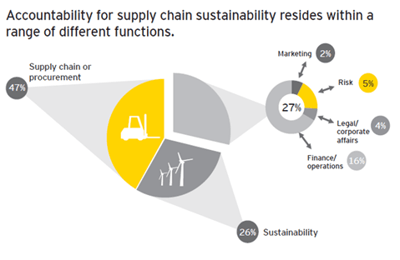In today’s increasingly interconnected and environmentally conscious business landscape, Environmental, Social, and Governance (ESG) disclosure has emerged as a critical factor that significantly influences the operations and decision-making processes of procurement teams. This article delves into the intricate relationship between ESG disclosure and procurement teams. We also aim to shed light on the transformative role it plays in shaping their strategies and priorities. Below are 4 key impacts of ESG disclosure and reporting on procurement teams.
1. ESG Frameworks and Standards Demand More Supplier Data
The increasing requirement to use frameworks and standards to disclose corporate ESG data means that there’s a bigger need for supplier data. Supply chains are an increasingly integral part of ESG reporting. This means that it’s more important than ever that companies can demonstrate a robust approach to assessing, managing, and improving their suppliers’ ESG performance.
Impact on procurement:
Procurement Teams Are a Key Stakeholder in Engaging Suppliers
Procurement is the area of the business with the most experience in engaging with suppliers. Therefore, it should be a key stakeholder in defining how suppliers can be engaged most effectively. Often this is by building on existing processes in relationships and if procurement is not involved in this initial phase of integrating ESG into purchasing and supply management then it’s likely that the long-term success of the program is in jeopardy.
Identification Of Relevant Suppliers
When starting supplier ESG programs, it’s often necessary to identify relevant or material suppliers. Procurement is key to this process and may be asked to provide supplier data sets that can support and inform the process. For example, this could be supplier categories, supplier spending, or indirect versus direct suppliers. The more up-to-date and centralized these records are the smoother the processes of identifying and engaging with the suppliers.
Front Line of Supplier Support
When defining the approach to capturing ESG metrics from suppliers, it’s also important to understand who’s going to be supporting the suppliers through this process. It’s likely that buyers or category managers within procurement will end up as the first line of support. If that happens, they need to understand what is being asked of the suppliers and why.
Contractual Obligations with Suppliers
Any requests for information or changes in supplier due diligence inevitably link to the agreements that you have in place with your suppliers. Therefore, it is important that supplier contracts reference ESG and disclosure requirements. These agreements are a key mechanism in achieving high levels of supplier engagement. Conversely, existing agreements may also impact the type of approach you can take with certain suppliers in terms of addressing ESG. Overall, procurement is likely to be responsible for reviewing existing agreements, updating contracts, and ensuring that they get put in place with suppliers.
2. Changing Corporate Accountability – ESG and Procurement Team Interactions
Another way in which the increasing need for ESG reporting in the supply chain impacts procurement is through the interactions within an organization. Accountability for supply chain sustainability is typically shared across the business. As discussed, procurement needs to support the design of the process, support suppliers and also review contractual agreements.

Source: UN Global Compact – The state of sustainable supply chains
The above diagram indicates that the responsibility can also extend to legal risk marketing, finance, as well as sustainability and procurement. The nature and scope of ESG data coupled with the rising importance of ESG disclosure globally, indicates how ESG risks can become legal, financial, and reputational risks to the companies and therefore involve multiple teams within a business.
Impact on procurement:
More Engagement And ‘Collaboration’ Across Companies
As a result of the shared accountability, procurement will likely enjoy greater visibility within the organization and therefore have to interact in more frequent and more dynamic ways with colleagues. It’s important to translate this engagement into collaboration, rather than anything negative. Otherwise, the sharing of data and ideas is unlikely to take place.
ESG Teams Now Define Supplier Information Requests
ESG teams will increasingly want to define what information suppliers need to provide and they’ll also need to access that data. It is important that systems that enable this, work for both procurement and the wider business. Single records of suppliers’ data and auditable databases of supplier interactions will be key to managing not only the increasing volumes of data but also increasing engagement with the suppliers.
Procurement Gatekeepers to The Relationships – Should This Change?
Procurement has historically been a gatekeeper to suppliers. There is a question as to whether this remains in place when organizations are now thinking of suppliers as an extension of their business. Procurement should continue to take a leading role, but ESG and sustainability teams are now increasingly forming an integral part of the ongoing supplier management and review process.
Understanding ESG Team’s Requirements
Procurement needs to understand the ESG team’s needs. It helps to understand the constant evolution of the ESG framework landscape and that they are under pressure from clients, investors, and other stakeholders to provide this information.
3. ESG Data Incorporated into Purchasing Decisions and Supplier Management Processes
Incorporating ESG data into purchasing decisions and management processes fundamentally impacts how procurement selects suppliers and assesses them on an ongoing basis.
Impact on procurement:
Skills And Knowledge Needed to Interpret Data
Companies need supplier data to make the decisions and improve performance, but they also need the skills and knowledge to interpret the data.
When making purchasing decisions based on ESG, data collection and interpretation can be done through a deep integration between sustainability and procurement. In other cases, teams can achieve that through clearly scored outputs from supplier assessments. This enables procurement to add ESG into any decision-making process with confidence.
Standardization Key for Comparability
Standardization is key for comparability across suppliers. However, different categories of suppliers or products are often going to be assessed on different aspects of ESG. It’s important to request data that are relevant to the supplier category. Also, procurement should be aware of why the same metrics might be weighted differently.
Ongoing ESG Performance and Change Over Time
The key challenge for procurement is that companies need to demonstrate improvement over time in relation to ESG performance. It’s no longer enough to have static disclosures from suppliers. Companies need to demonstrate where they’ve come from and where they’re going. As a result, this will need to feed into the wider supplier performance review process.
4. Heightened Profile of ESG at C-suite and Board Level
The heightened profile of ESG within businesses is resulting in increased exposure and responsibility for procurement teams.
Impact on procurement:
ESG Now Has Board Level Representation
Climate change is one of the biggest financial risks to multinational companies and ESG is increasingly being represented at the Board level. At the C suite level, we’re increasingly seeing reports of remuneration being tied to the ESG performance of the organization. And we are likely to see this cascading down through all levels of the procurement teams.
Procurement Intrinsically Linked to ESG Disclosure
The global pandemic highlighted that sustainable supply chains are integral to forming resilient organizations. As such they are a key metric for strong ESG performance. As a result, procurement will be involved far more in both company reporting and contributing to winning new business. In fact, supply chain processes and supplier ESG will be key elements to both.
Increased Responsibility Placed on Procurement Teams
Supply chains now represent a higher reputational and compliance risk to businesses than ever before. This increases the importance of procurement integrating ESG into all practices, but it also dramatically increases the responsibility of those involved. With ESG reporting being at the forefront of customers, consumers, employees and investors meaningful ESG data and interpretation of the data is more important than ever.
Cority’s Supply Chain Sustainability Software
Cority’s supply chain sustainability software solution provides your business with a single point of transparency across your supplier network, ensuring that compliance, performance, and risk can be managed seamlessly.
If you’d like to discuss our supply chain sustainability software in more detail, please do not hesitate to get in touch with us. We are proud to be working with several organizations to enable responsible supply chains, and partner with our clients to help them achieve their sustainable supply chain goals.











